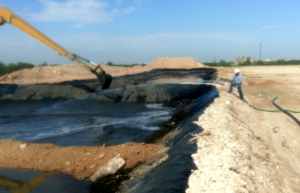Effluent Treatment and Disposal
As manufactured, BioSolve products contain no hazardous or regulated ingredients and do not meet the definition of hazardous waste. However, the intended use of this product as remediation and/or surface washing agent will produce wastewater containing emulsified and dispersed hydrocarbons that may be classified as hazardous (regulated) waste and should be treated and disposed of accordingly.
Large Volume
Larger scale or long-term soil remediation projects or large tank cleaning projects may justify onsite treatment. These onsite treatment operations range from trailer mounted system capable of handling several thousand gallons a day to custom designed permanent installations capable of handling 10,000 gallons per day or more. Most of these systems include the following components:
- Settling Tank
- Oil-water Separator
- Filtration (to remove residual oil and solids)
- Actiated carbon (to remove residual organics)
In some cases, water discharged from these systems is clean enough to be recharged to the aquifer. In other systems the water can be reused to prepare a new surfactant solution for additional treatment.
Impact on Wastewater Treatment Plants
Independent testing indicates that BioSolve Pinkwater has no adverse impact on operations at wastewater treatment plants. Tests found that aerobic bacteria and spore counts at a waste water treatment plant were the same or higher after exposure to a 6% and a 15% solution of Pinkwater for 48 hours. BioSolve Activator is a readily biodegradable product which is presumed to have no adverse impact on wastewater treatment plant bacteria.
Disposing of Small Quantities of BioSolve Products
Small quantities of unused and uncontaminated product may be discharged to a qualified wastewater treatment facility. However, we recommend obtaining approval from local regulatory agencies prior to discarding any BioSolve products into public sewers. Never discharge BioSolve products into storm drains without express authorization of regulatory authorities.







